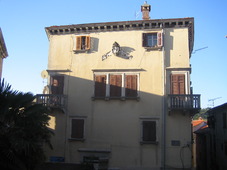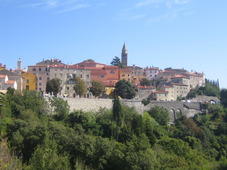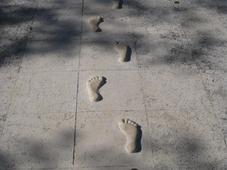to enlarge


or choose the place
from the menu below
 Rome |
 Byzantium |
 Venice |
 Vienna |
 Brioni |
 Smrikve |
 |
 |
 During the 17th century there were two Labin’s Podesta’ from Bollani family.
Another coat of arms placed on the façade in 1658 belonged to Nicolo’ Bembo, a Venetian Podesta’ of Labin.
During the 17th century there were two Labin’s Podesta’ from Bollani family.
Another coat of arms placed on the façade in 1658 belonged to Nicolo’ Bembo, a Venetian Podesta’ of Labin.
The southern part of the square is closed by the Scampicchio palace from the 16th century that has two interesting balconies placed on the angles of the façade and a big stone made family coat of arms placed in the middle and nearby the top of the façade. The main façade has a lovely doorway made in 1570.
Family Scampicchio was in origin from Rijeka. It is interesting the fact that in 1580 this family donated a land to the Church to allow the construction of presbytery and in turn the Pope Ubrano VIII allowed the family to built a chapel in the northern part of their palace and link it to the Parish Church of the Nativity of the Blessed Virgin Mary. This right was reconfirmed to the family in 1735 by the Pope Clemente XII.
Also family Scampicchio built a countryside complex together with family Polesini. You can see this complex in Sv. Ivan near Porec. It is assumed that this complex was made following the drawings of the great Renaissance architect Andrea Palladio and is really interesting property.
There is a small street that goes between the Parish Church and Scampicchio palace that will bring you near the small gate.
 If you continue to walk on the road that continues nearby the eastern walls of the town you will
also find several monuments of prominent Istrians. Below the girdle, in the southern part of the old town, outside the last
buildings of the old town, that were realized in the 17th century, there was an old Roman well.
If you continue to walk on the road that continues nearby the eastern walls of the town you will
also find several monuments of prominent Istrians. Below the girdle, in the southern part of the old town, outside the last
buildings of the old town, that were realized in the 17th century, there was an old Roman well.
Labin is an important Istrian town and it is really a nice visit if you are in the eastern part of Istria. In Labin’s photo gallery you will find few pictures of this beautiful Istrian town.
Not far from Labin is Dubrova, a sculpture park presenting works of sculptors from all around the world. For years the artists have been gathering in this traditional art event founded in 1970 by the Istrian sculptor and artist Josip Diminic.
This traditional event is named Mediterranean Sculptors' Symposion and was created with the idea of helping the revitalisation of the old Francovich family property. The most famous person from Labin - Matija Vlacic belonged to this noble Istrian family. The rivitalisation of the property is still to be completed.
 The artistical
"white road", part of the sculpture park, was created over the years. Various famous artists such as: Kozaric, Murtic,
Dzamonja, Knifer, Peric, Kovacevic, Bogdanic, Dzaja, Smerdu, Bassani, Milic, Briski and Rasic worked on it and every
artist created 25 meters of this artistic road. Todays "white road" was in origin the old road that lead to the entrance of
Villa Francovich.
The artistical
"white road", part of the sculpture park, was created over the years. Various famous artists such as: Kozaric, Murtic,
Dzamonja, Knifer, Peric, Kovacevic, Bogdanic, Dzaja, Smerdu, Bassani, Milic, Briski and Rasic worked on it and every
artist created 25 meters of this artistic road. Todays "white road" was in origin the old road that lead to the entrance of
Villa Francovich.
Unfortunately only part of the old buildings of Villa Francovich host a nice restaurant named Dubrava but most other buildings would require total restructuring.
LABIN – HISTORICAL OVERVIEW
This town is another very old Istrian town and its architecture is among the best examples in Istria of the thousands of year life continuity in a human settlement. The oldest part of the town conserve the medieval aspects but its street structure dates back many centuries before the Middle Ages.
It was a prehistoric hill fort and later on a Roman settlement named Alvona. During the Roman period Labin had a status of municipality. Labin also used the water from the aqueduct that Romans built from the Ucka Mount until Pula.
Some of the most important Labin’s families during the Roman period were: Gavillii, Ceionii, Verazii, Granii.